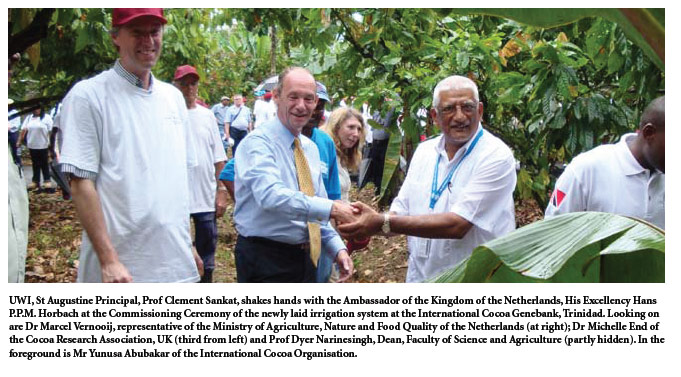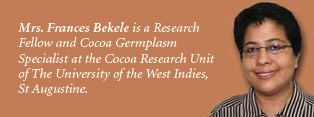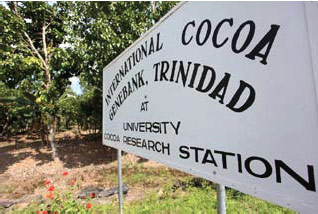 |
 |
 |
|
April 2009
|
Rebuilding the Cocoa Industry
Yet over the last three decades, cocoa production, exports, acreage under cultivation and farmer participation in T&T have been declining steadily. Approximately 2,000 farmers now grow cocoa locally (compared to 10,000 in 1966). During the last five years, total local production has not exceeded 1.6 million kgs (metric tonnes) per annum. With low cocoa yields (less than 300 kg/ha), production costs were cited as TT$7-11/kg in 1999. Currently, farmers receive TT$20/kg for Grade 1 cocoa. Only 10% of those farmers are between the ages of 20 and 40 while 85% are between 40 and 55. There is a drive to attract youth to cocoa farming, and to create value-added enterprises based on cocoa. Ten cocoa farmers’ groups have been formed nationally with the help of the Cocoa and Coffee Industry Board (CCIB). The groups meet monthly, and are targeted for training by the Cocoa Stakeholders Committee, which was launched by The Ministry of Agriculture, Land and Marine Resources (MALMR) in May 2008. Three key Divisions in the MALMR, viz., the Research, Agricultural Services and the Extension Training and Information Services work together to ensure that farmers have access to superior planting material and are informed about recommended practices for growing, harvesting and processing cocoa. The CCIB was launched by an Act of Parliament in 1961 to “secure the most favourable arrangements for the purchase, sale, handling, grading, exportation and marketing of cocoa as well as coffee for the benefit of the industry.” The CCIB has expanded its role to “encourage cocoa production” in order to continue to attract premium prices and sustain and satisfy the demand for local cocoa. With the Agricultural Development Bank, CCIB has launched The Cocoa Revitalizer Programme, which has financially assisted 246 farmers on a total of 2390 acres. At the Cocoa Research Unit (CRU), research is ongoing; including studies on diversity assessment, screening for Witches’ Broom and Black Pod disease resistance, germplasm enhancement (pre-breeding) and flavour assessment, among others. The results of the CRU’s various research activities are well documented and have been of enormous value to cocoa researchers worldwide. CRU manages one of the largest and most diverse collections of cacao germplasm in the world, the International Cocoa Genebank, Trinidad (ICG, T). The genetic resources conserved in the ICG, T are actively being used to benefit the local and international cocoa industries. The CRU’s research, coupled with the superior planting material from MALMR, attractive incentive programmes and other efforts of MALMR and CCIB, should encourage existing farmers and stimulate interest in the industry among the youth. It is critical that problems associated with access to capital and land tenure be addressed. This approach will offset the constraints of labour, and the high per capita costs associated with the primary processing of cocoa. With increased production, it will be possible to add value to the primary product through down-stream processing. This could include the use of by-products and wastes such as the pod wall or husk to produce livestock feed. There is also a potential to produce specialty products such as cocoa juices, liquors, ice cream, jams, and jellies among others. Everything is in place; all we need is the will. Cocoa Research Unit at work
Its primary research activities are to make cocoa planting material available with improved traits such as: high yield potential, disease resistance, high fat content and good flavour characteristics. It is also the custodian of the International Cocoa Genebank, Trinidad (ICG, T), and in that role, has focused on the conservation, characterisation (both morphological and molecular), evaluation and enhancement and use of the collection. The ICG, T has 12,000 trees making up its 2,300 accessions, which are groups of trees belonging to the same family. Work in these four areas is funded through research projects with international commodity bodies such as the United Nations Common Fund for Commodities, Bioversity International and the World Cocoa Foundation. Currently at CRU, there are 10 internationally and locally funded collaborative research projects centered on the ICG, T. Many of these projects include active co-financing and counterpart contribution from within the chocolate industry. The CRU’s work involves continuously seeking new venues for funding, and disseminating its research findings in various local and international conference proceedings, newsletters and peer-reviewed journals. The CRU functions at several levels. It provides training and quality assessments to the Ministry of Agriculture, Land and Marine Resources (MALMR) in screening new commercial type cocoa types before they are released to farmers. Cocoa accessions identified from its germplasm screening and enhancement programme for Black Pod and Witches’ Broom diseases are distributed internationally via quarantine to cocoa breeding programmes and also form part of the MALMR’s local breeding programme. It screens the quality of beans from cocoa buying agents and trains them and fermentary operators in optimal cocoa post harvest processing for the Cocoa and Coffee Industry Board. It works directly with some large farmers (who ship their cocoa privately and directly to chocolate manufacturers) to maintain high quality. It is part of the National Cocoa Stakeholders Steering Committee and Working Group, helping to train farmers and guide the rebuilding process. The CRU also collaborates with other research centres such as CIRAD (Centre de Coopération Internationale en Recherche Agronomique pour le Dévelopment, France) and universities (such as Hamburg, Germany and Towson, USA) along with other UWI departments. For instance, Dr Ivan Chang Yen of UWI’s Department of Chemistry is involved in two State-funded projects; one that looks at heavy metals and Ochratroxin A (a fungal toxin) in local cocoa beans. This is primarily to protect the health of consumers and will enable a Hazard Analysis and Critical Control Point (HACCP)-based system for cocoa production, and thus a system of certification. The other project led by Dr Chang Yen is based on the findings that dark chocolates contain healthy anti-oxidant and nutritive properties, known as neutraceuticals. Since the level of these neutraceuticals in local cocoa is unknown, the project seeks to “chemically characterise the flavour and neutraceutical content of local cocoa beans and to correlate their chemistries to their respective sensory qualities.” Ever since local cocoa research began, the task of assembling the ICG, T has spanned 60 years of effort, largely driven by the succession of reputable scientists associated with this historical centre of excellence.
|


 A ready market exists for all the cocoa Trinidad and Tobago can produce because of its premium quality and lack of restrictive quotas. The reputation of T&T’s cocoa as 100% fine or flavour is well-known, and this cocoa is sought by manufacturers of delectable dark chocolates. This is why Trinidad and Tobago’s cocoa currently commands between US $4,500 to $5,300 per tonne compared to US $2,300 per tonne paid for bulk cocoa (used to make high-volume chocolate lines).
A ready market exists for all the cocoa Trinidad and Tobago can produce because of its premium quality and lack of restrictive quotas. The reputation of T&T’s cocoa as 100% fine or flavour is well-known, and this cocoa is sought by manufacturers of delectable dark chocolates. This is why Trinidad and Tobago’s cocoa currently commands between US $4,500 to $5,300 per tonne compared to US $2,300 per tonne paid for bulk cocoa (used to make high-volume chocolate lines). The Cocoa Research Unit’s (CRU) research is core funded by the Government of Trinidad and Tobago and international partners such as the Cocoa Research Association (UK).
The Cocoa Research Unit’s (CRU) research is core funded by the Government of Trinidad and Tobago and international partners such as the Cocoa Research Association (UK).